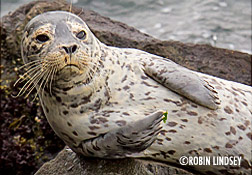ABOUT HARBOR SEALS
PHYSICAL DESCRIPTION
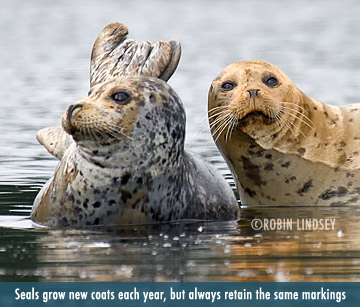 5-6 feet in length and weighing up to 300 pounds, males are slightly larger than females.
5-6 feet in length and weighing up to 300 pounds, males are slightly larger than females.
Harbor seals have coats that vary in color, from silver-gray to brown or black and are typically covered with many fine to medium spots. The mottled coats provide excellent camouflage on pebbled beaches.
Like all true seals or commonseals, they have no external ear flaps and small flippers with a short tail.
Unable to rotate their rear flippers, they are awkward on land and move bouncing along on their bellies. To view video showing harbor seal locomotion, please click here.
RANGE AND HABITAT Harbor seals are found in both the Atlantic and Pacific north of the equator. In the Northern Pacific they range from Alaska to Baja, Mexico. They inhabit shallow waters close to shore and favor sandbars and beaches and haul out at low tide to rest and warm up.
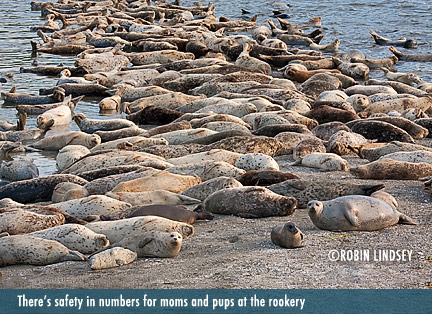 MATING AND BREEDING Most male and female harbor seals become sexually active at ages three to six or seven years. Adult females usually mate and give birth to one pup every year; the size of a pup can be 1/4 to 1/3 that of the mother. The gestation period is 9-11 months. Females will give birth on shore, on ice floes and in the water.
MATING AND BREEDING Most male and female harbor seals become sexually active at ages three to six or seven years. Adult females usually mate and give birth to one pup every year; the size of a pup can be 1/4 to 1/3 that of the mother. The gestation period is 9-11 months. Females will give birth on shore, on ice floes and in the water.
Mating resumes shortly after the female has given birth and delayed implantation appears to ensure that pups are born in the proper season with a higher survival rate. Harbor seal males are somewhat more monogamous than some pinnipeds, mating with one to several females per year. Harbor seals usually return to the same breeding grounds every year.
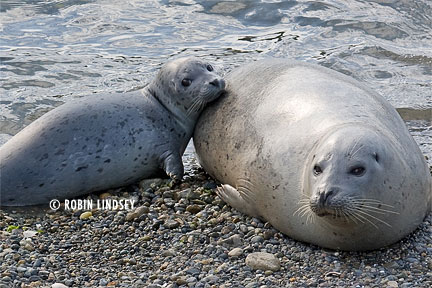 PUPPING In South Puget Sound, harbor seal pups are born late June through September (map for pupping timeframes in Washington State) and weigh about 18-30 pounds. If born prematurely or early in the birthing season, harbor seals retain a whitish lanugo coat (which is usually lost before birth). Full-term pups are born well-developed and able to swim at birth. They make a noise that sounds like "maaaa"and are very vocal with their mothers. Once they have been weaned the vocalizations subside.
PUPPING In South Puget Sound, harbor seal pups are born late June through September (map for pupping timeframes in Washington State) and weigh about 18-30 pounds. If born prematurely or early in the birthing season, harbor seals retain a whitish lanugo coat (which is usually lost before birth). Full-term pups are born well-developed and able to swim at birth. They make a noise that sounds like "maaaa"and are very vocal with their mothers. Once they have been weaned the vocalizations subside.
Harbor seal mothers are extremely affectionate with their pups and form a strong bond immediately after birth. They nurse their young both on land and in the water. The pup usually accompanies mom on short swims around the haul out. Sometimes, if a pup is not strong enough, the pup will be alone onshore.
The females produce a very high-fat content milk containing important antibodies. After about four weeks, the pups are weaned and have doubled their birth weight. Pups and their moms haul out at locations called rookeries where many harbor seals gather to nurse and prepare their young for life in the wild. Watch WDFW's SealCam for a real-time glimpse at a harbor seal rookery in South Puget Sound. See the birth of a harbor seal pup here.
Want to learn more about harbor seal pups and what to do if you come across one resting onshore? Go here.
PHYSICAL DESCRIPTION

Harbor seals have coats that vary in color, from silver-gray to brown or black and are typically covered with many fine to medium spots. The mottled coats provide excellent camouflage on pebbled beaches.
Like all true seals or commonseals, they have no external ear flaps and small flippers with a short tail.
Unable to rotate their rear flippers, they are awkward on land and move bouncing along on their bellies. To view video showing harbor seal locomotion, please click here.
RANGE AND HABITAT Harbor seals are found in both the Atlantic and Pacific north of the equator. In the Northern Pacific they range from Alaska to Baja, Mexico. They inhabit shallow waters close to shore and favor sandbars and beaches and haul out at low tide to rest and warm up.

Mating resumes shortly after the female has given birth and delayed implantation appears to ensure that pups are born in the proper season with a higher survival rate. Harbor seal males are somewhat more monogamous than some pinnipeds, mating with one to several females per year. Harbor seals usually return to the same breeding grounds every year.

Harbor seal mothers are extremely affectionate with their pups and form a strong bond immediately after birth. They nurse their young both on land and in the water. The pup usually accompanies mom on short swims around the haul out. Sometimes, if a pup is not strong enough, the pup will be alone onshore.
The females produce a very high-fat content milk containing important antibodies. After about four weeks, the pups are weaned and have doubled their birth weight. Pups and their moms haul out at locations called rookeries where many harbor seals gather to nurse and prepare their young for life in the wild. Watch WDFW's SealCam for a real-time glimpse at a harbor seal rookery in South Puget Sound. See the birth of a harbor seal pup here.
Want to learn more about harbor seal pups and what to do if you come across one resting onshore? Go here.
SENSES Harbor seals have a highly developed sense of hearing. Their hearing is almost 14x more acute underwater than on land. Their sense of hearing is important for their protection against predators. Seals in the Pacific Northwest have learned to distinguish the differing communications of the mammal-eating transient killer whales (orcas) and harmless resident pods, who prefer salmon.
Harbor seals’ large, dark eyes are well adapted for underwater vision, but they have poor eyesight on land and appear not to see in color. Their eyes are covered with a protective mucus which coats the eyes underwater and often appears as a wet ring around them when they are onshore. Large, wet rings around the eyes is an indication of well hydrated seal pup.
Harbor seals can detect prey by using nerves in their whiskers or vibrissae that sense a change in pressure or vibrations in the water. Harbor seals use their acute sense of smell to find a lost pup. Unlike sea lions, harbor seals rarely vocalize on land except during pupping season or when threatened. They often communicate by slapping the water with their flippers. Underwater, however, seals communicate using a series of eerie sounds. View documentary video of waddell seals underwater in Antarctica.
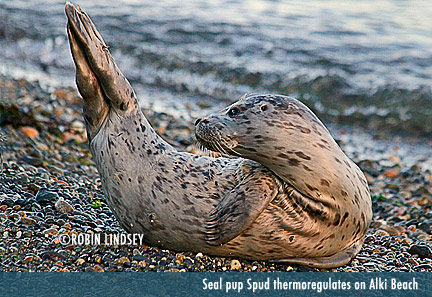 BEHAVIOR Harbor seals spend about half their time on land and half in water. and they are able to sleep in the water for up to 30 minutes.
BEHAVIOR Harbor seals spend about half their time on land and half in water. and they are able to sleep in the water for up to 30 minutes.
On land, they regulate their body temperature (either warming up on cold days or cooling down on hot ones) by raising rear and/or front flippers, called the banana pose. They can often be seen doing similar behavior in shallow water.
Although they are able to dive to depths of 650 feet and stay submerged for over 20 minutes, they typically dive to a much shallower depth where their food is located. Their diet consists of many varieties of fish as well as octopus and squid.
Harbor seals are usually solitary animals except during breeding season or when hauled out. Once weaned, pups form bonds with other young seals for protection and no longer accompany their mothers. View video of a seal's watery world.
NATURAL PREDATORS The harbor seal’s main predators are orcas, sharks and polar bears. Coyotes, bears, eagles, stellar sea lions and walruses often prey on unprotected or sickly pups.
HUMAN IMPACT Once widely hunted for their luxurious coat and rich blubber (government sanctioned hunting of seals still takes place in some regions such as Scotland, Norway and Iceland), modern man creates additional risks to all species of seals and their pups. Canada, whose annual harp seal hunt has killed many thousands of defenseless seal pups on the Eastern seaboard, has now proposed a grey seal hunt, in order to sell seal penises to Asian markets.
Seals often drown by entanglement in commercial fishing nets, gillnets in particular. Seals also suffer serious wounds from nets, fishing line and barbs that can lead to infections and death. Additionally, they are sometimes intentionally killed by fishermen who erroneously believe they are responsible for reduced fish stocks caused by overfishing, habitat destruction and pollution.
Environmental pollution has created an extreme risk for harbor seals and other marine mammals. Polluted waters lead to low body weight, infections and increased susceptibility to viruses and parasites, often resulting in death.
Links for learning more about harbor seals.
Harbor seals’ large, dark eyes are well adapted for underwater vision, but they have poor eyesight on land and appear not to see in color. Their eyes are covered with a protective mucus which coats the eyes underwater and often appears as a wet ring around them when they are onshore. Large, wet rings around the eyes is an indication of well hydrated seal pup.
Harbor seals can detect prey by using nerves in their whiskers or vibrissae that sense a change in pressure or vibrations in the water. Harbor seals use their acute sense of smell to find a lost pup. Unlike sea lions, harbor seals rarely vocalize on land except during pupping season or when threatened. They often communicate by slapping the water with their flippers. Underwater, however, seals communicate using a series of eerie sounds. View documentary video of waddell seals underwater in Antarctica.

On land, they regulate their body temperature (either warming up on cold days or cooling down on hot ones) by raising rear and/or front flippers, called the banana pose. They can often be seen doing similar behavior in shallow water.
Although they are able to dive to depths of 650 feet and stay submerged for over 20 minutes, they typically dive to a much shallower depth where their food is located. Their diet consists of many varieties of fish as well as octopus and squid.
Harbor seals are usually solitary animals except during breeding season or when hauled out. Once weaned, pups form bonds with other young seals for protection and no longer accompany their mothers. View video of a seal's watery world.
NATURAL PREDATORS The harbor seal’s main predators are orcas, sharks and polar bears. Coyotes, bears, eagles, stellar sea lions and walruses often prey on unprotected or sickly pups.
HUMAN IMPACT Once widely hunted for their luxurious coat and rich blubber (government sanctioned hunting of seals still takes place in some regions such as Scotland, Norway and Iceland), modern man creates additional risks to all species of seals and their pups. Canada, whose annual harp seal hunt has killed many thousands of defenseless seal pups on the Eastern seaboard, has now proposed a grey seal hunt, in order to sell seal penises to Asian markets.
Seals often drown by entanglement in commercial fishing nets, gillnets in particular. Seals also suffer serious wounds from nets, fishing line and barbs that can lead to infections and death. Additionally, they are sometimes intentionally killed by fishermen who erroneously believe they are responsible for reduced fish stocks caused by overfishing, habitat destruction and pollution.
Environmental pollution has created an extreme risk for harbor seals and other marine mammals. Polluted waters lead to low body weight, infections and increased susceptibility to viruses and parasites, often resulting in death.
Links for learning more about harbor seals.
SEAL PUP INFO
Why is there a seal pup alone on the beach? What are some common mistakes to avoid? Why is it important to stay back? When is harbor seal pupping season?
Learn about pups here.
Why is there a seal pup alone on the beach? What are some common mistakes to avoid? Why is it important to stay back? When is harbor seal pupping season?
Learn about pups here.
